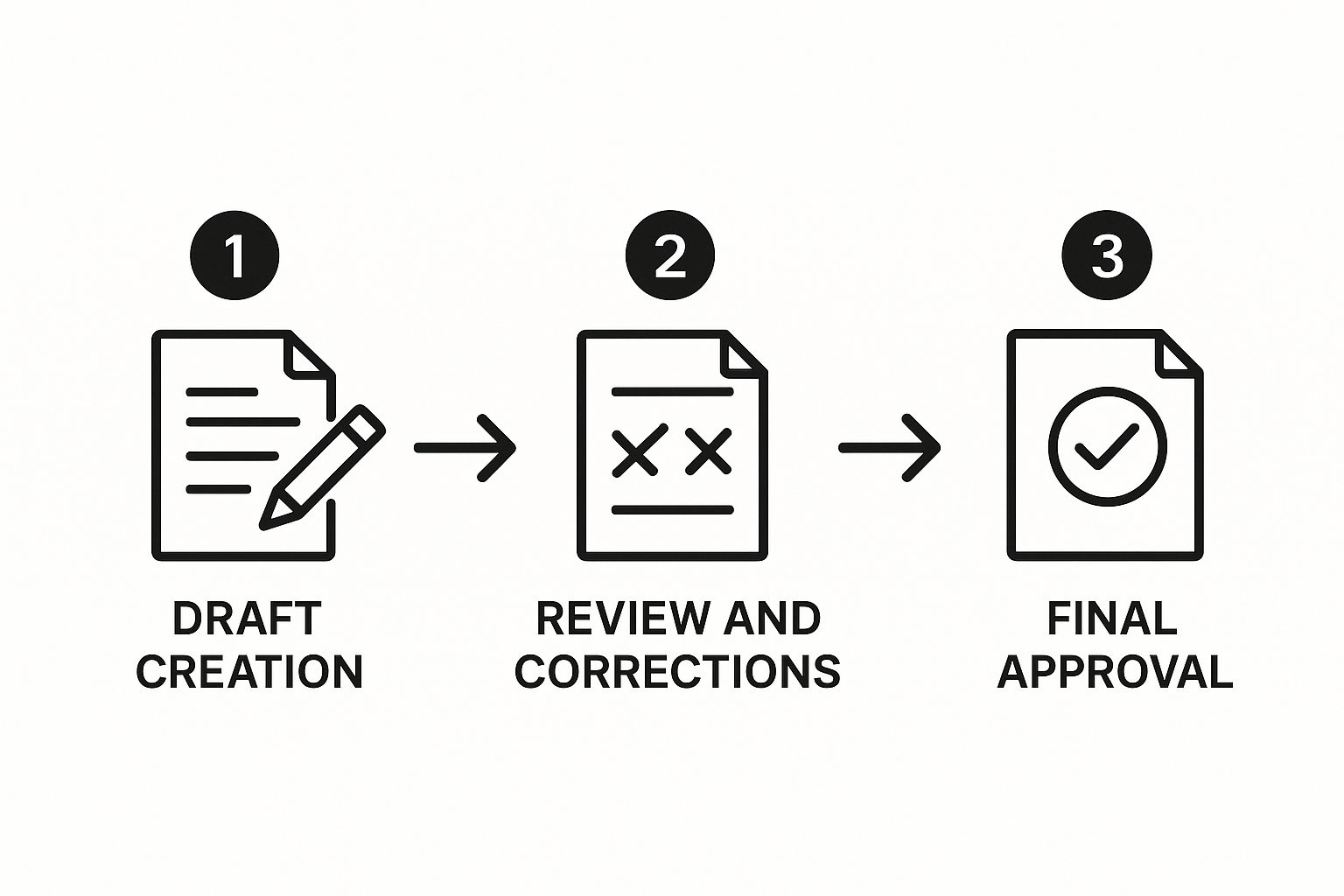A Modern Content Creation Workflow That Actually Works

A solid content creation workflow is simply the system your team follows to get content from a rough idea to a finished, published piece. Think of it as the playbook that swaps chaos for clarity, making sure every single asset gets created efficiently and actually hits your quality standards.
Moving Beyond the Content Treadmill
Does your content process feel like a frantic, last-minute scramble to hit deadlines? If so, you're not alone. So many teams get stuck on the "content treadmill," where the main goal is just to pump out more stuff instead of producing strategic, high-impact work. This approach always leads to problems.
The signs are probably familiar: missed deadlines, wildly inconsistent quality, and a team that’s just plain burned out. You pour in tons of effort, but the results just aren't there. Why does this happen? Usually, it's because the process itself is reactive, not proactive.
The Problem with Making It Up As You Go
Without a structured content creation workflow, every new blog post or carousel is a brand-new project with its own set of problems. This is where things get messy and inefficient. Key steps get skipped, feedback gets lost in endless email chains, and the final piece never quite reaches its full potential. It's a system that accidentally values speed over smarts.
The data backs this up. A shocking 71% of B2B marketers admit they don't have a documented content strategy. And for the ones who do, only 29% feel it’s actually working well. The biggest hurdles? Unclear goals and content that doesn't line up with what customers actually need. You can dig into more of these content marketing statistics to see just how much a real strategy matters. A good workflow fixes these issues at their core.
A great workflow isn’t about creating more rules and red tape. It’s about getting rid of the guesswork. It frees up your team’s brainpower to focus on what really moves the needle—being creative, telling great stories, and thinking strategically.
Before we dive into building our workflow, it’s helpful to see the common pain points laid out. This table breaks down the frequent struggles we all face and points toward the foundational solutions we’ll be building on.
From Common Bottlenecks to Strategic Solutions
| Common Bottleneck | Typical Symptom | Strategic Solution Principle |
|---|---|---|
| Reactive Ideation | "We need a blog post for next week... any ideas?" | Generate ideas based on data, keywords, and audience pain points. |
| Inconsistent Briefs | Writers and designers work from vague instructions, leading to major revisions. | Use standardized, detailed briefs that align everyone from the start. |
| Chaotic Feedback | Conflicting feedback arrives from multiple people via email and Slack. | Centralize all reviews and feedback in one place with clear action items. |
| No Pre-Publish Checklist | Content goes live with broken links, missing meta descriptions, or poor formatting. | Implement a final "pre-flight" check to ensure every piece is optimized. |
| Team Burnout | Constant pressure and unclear processes lead to frustration and fatigue. | Create a predictable, transparent system that makes work manageable. |
Seeing it this way helps clarify that these aren't isolated issues but symptoms of a broken system. Now, let's fix it.
Building a Predictable Content Engine
The answer is to build a reliable engine for creating excellent content, time and time again. This means documenting a system that everyone on your team not only understands but actually uses. It transforms content from a chaotic art project into a dependable business process.
A strong workflow brings clarity to every single stage:
- Ideation: Ideas come from data and strategic goals, not just random brainstorming sessions.
- Creation: Writers and designers get clear, consistent briefs, so everyone is on the same page from day one.
- Review: Feedback is organized and constructive, which stops those frustrating bottlenecks before they start.
- Publishing: A simple checklist guarantees every single piece is polished and optimized before it ever sees the light of day.
This guide is your blueprint for building that very engine. Let's get started.
Building Your Strategic Ideation Engine

The best content doesn’t just happen by chance. It comes from a solid strategy, not a last-minute scramble for ideas. The ideation phase of your content creation workflow is probably the most important part of the whole process because it sets the stage for everything else.
If you want to move past just aimless brainstorming, you need a real system for finding high-impact content opportunities. Think of it as your strategic ideation engine.
This engine has three main fuel sources: deep audience research, smart competitor analysis, and targeted keyword research. It’s about changing the question from "What should we post about?" to "What problems can we solve for our audience that our competitors are completely missing?"
This small shift in thinking is huge. It turns your content from just another marketing expense into a real asset that pulls people in, keeps them engaged, and ultimately converts. It means every single piece of content has a clear purpose before you ever start creating it.
Uncovering What Your Audience Really Wants
Let's be honest, the best ideas come straight from your audience. They're telling you what they need all the time—you just have to listen. This is where you ditch the guesswork and start using data to find out what really matters.
Good audience research means you're doing things like:
- Social Listening: Pay attention to conversations happening on the platforms where your audience actually spends their time. What questions are they asking? What are their biggest headaches related to your industry?
- Customer Feedback: Seriously, dig into your support tickets, sales call notes, and customer reviews. These are absolute goldmines for finding the real-world problems your content can solve.
- Community Engagement: Jump into relevant Reddit communities, Facebook groups, or industry forums. Just by watching how people talk, you’ll pick up on the language and topics that actually resonate.
When you ground your ideas in these sources, you're making sure you create content people are already looking for. For a much deeper look, check out our guide on content marketing best practices that will help you sharpen your strategy even more.
Developing Your Living Content Calendar
A content calendar should be more than just a list of publish dates. It's a living, breathing document that connects your content strategy directly to your business goals. It’s what brings your ideation to life by matching every topic to a specific point in the customer journey.
The explosion of the creator economy shows just how vital these organized systems are. With over 64 million YouTube creators and 165 million new creators joining social platforms since 2020, the days of winging it are over. The need for a proper workflow has never been greater. You can read more about these creator economy trends and how they impact workflows.
An effective content calendar doesn't just plan what you'll publish and when. It connects each content idea to a specific business goal, a target audience segment, and a desired action, turning your content plan into a strategic roadmap.
This approach gives your content creation workflow real purpose. For example, a blog post might be planned to build top-of-funnel awareness, while a Lumeo carousel is specifically designed for mid-funnel engagement on LinkedIn. When it’s all tracked in your calendar, your publishing schedule stops being a simple to-do list and becomes a powerful strategic tool.
The AI-Assisted Content Production Line
Alright, you’ve got your big ideas and a solid strategy. Now it's time to actually make things. This is where a smooth content creation workflow separates the pros from the amateurs, turning those approved concepts into real, high-quality assets without burning out your team. The goal isn't to build a soulless factory; it's to create an efficient assembly line for great content.
This whole process kicks off with an airtight content brief. A great brief is your north star—it kills the guesswork by clearly laying out the goal, who you're talking to, the main keyword, key talking points, and the right tone of voice. When writers and designers have that clarity from day one, you’ll see revision cycles shrink and the final piece will actually match the original vision.
Speeding Up Production with AI
This is where AI becomes your new best friend in the creative process. I'm not talking about replacing your team's creativity. Far from it. It's about letting AI do the heavy lifting so your people can focus on what they do best: telling compelling stories and adding that strategic, human polish.
Think of AI as the ultimate accelerator for the most tedious parts of content creation. You can use it to:
- Generate Initial Drafts: Plug your detailed brief into an AI and get a structured first draft, complete with headings and foundational paragraphs. This gives your writer a running start, not a scary blank page.
- Create Outlines: Instantly build a logical outline based on your keyword research and what competitors are doing. This ensures you cover all the essential subtopics without missing a beat.
- Brainstorm Angles: Stuck on a headline? Give the AI a topic and ask for ten different hooks. You’ll quickly find a more compelling way to frame your message for your audience.
The infographic below really nails the core flow of this production stage, showing how content moves from a rough idea to a finished piece.

It’s a simple visual, but it highlights a crucial point: having a structured process stops content from getting stuck in that dreaded "review limbo."
From Text to Engaging Visuals
AI's magic doesn't stop with text. In a world dominated by social media, turning a deep-dive blog post or even a single powerful quote into an eye-catching visual is non-negotiable. This is where tools like Lumeo are an absolute game-changer.
You can grab the core message from your long-form content and, in minutes, spin it into a slick, professional carousel for LinkedIn or Instagram. This isn’t just about saving time; it's about multiplying the value of every single piece of content you produce. If you want to dive deeper, check out our guide on automated content creation for more ideas.
Integrating AI isn’t an all-or-nothing decision. It's about strategically inserting tools at friction points to boost efficiency, giving your human experts more time to add irreplaceable value.
This isn't just a trend; it's rapidly becoming the standard. The latest research shows a staggering 90% of content marketers are planning to use AI in their 2025 strategies. The top uses? Outlining (71.7%) and brainstorming (68%). And the data shows AI users are reporting more success than those who don't use it. You can see more of the breakdown in these content marketing AI statistics and their impact.
For those looking to really level up, it's worth exploring advanced AI systems for longform video creation that can automate huge chunks of the video production pipeline. By weaving tools like Lumeo and other specialized AI into your workflow, you build a modern, powerful production line that delivers top-tier content across all your channels, consistently.
Designing a Painless Review and Approval Process

This is where even the most well-oiled content machine can grind to a halt. The review and approval cycle, if you don't get it right, quickly spirals into a mess of confusing email threads, conflicting notes, and endless delays that just kill your team's morale.
The secret to dodging this chaos? Building a collaborative feedback loop that actually makes the content better instead of just slowing everything down. It’s all about ditching disorganized communication for a central, structured system where everyone knows exactly what they’re supposed to do.
Defining Clear Roles for Stakeholders
First things first, you have to solve the "too many cooks in the kitchen" problem. Not everyone needs to give their opinion on every little detail. When you assign clear roles, the whole process gets faster and the feedback becomes infinitely more valuable.
Here’s a setup that works wonders:
- The Editor: They're focused on grammar, style, tone, and overall flow. Their job is to make sure the content hits all your brand's voice and quality benchmarks.
- The Subject Matter Expert (SME): This person has one job: check for technical accuracy. They aren't worried about comma splices; they're making sure the information is correct and credible.
- The Final Approver: This is usually a marketing lead or manager who gives the final thumbs-up. They trust the editor and SME have done their parts and are mainly checking that the content meets the strategic goals from the brief.
This kind of structured approach is a cornerstone of building a better social media workflow, too. It brings a sense of order to what can easily become a free-for-all.
When you're working with clients or outside agencies, that need for clarity is even more intense. To keep your projects moving smoothly, especially during this critical stage, it pays to learn how to streamline your client approval process.
Giving and Receiving Better Feedback
Once the roles are set, the next step is improving the quality of the feedback itself. Vague comments like "I don't like this" or "make it pop more" are completely useless. You need to build a culture of constructive, actionable feedback.
The goal of a review isn't to critique the creator; it's to improve the content. Frame all feedback around the piece itself and tie it back to the original goals outlined in the brief.
Push your team to get specific. Instead of just saying a paragraph is confusing, they should suggest a clearer way to phrase it. If a design element feels off, they need to explain why it doesn't align with the brand guide. This simple shift turns feedback from a potential source of conflict into a genuinely helpful, collaborative exercise.
Ultimately, a painless review process hinges on having a central hub—think Google Docs for text or Figma for design—where all comments live in one place, visible to everyone. This transparency puts a stop to conflicting feedback and creates a single source of truth, turning your review phase from a dreaded bottleneck into a step that adds real value to your workflow.
Giving Your Content the Audience It Deserves
Hitting "publish" is the starting gun, not the finish line. I’ve seen it a hundred times: a team pours their heart into a flawless piece of content, only for it to sit in a quiet corner of their website, unseen. All that hard work is wasted without a real plan to get it in front of the right people. This is where your content creation workflow proves its worth, making sure your effort actually connects with your audience and drives results.
Before anything goes live, it absolutely has to go through a final pre-flight check. It’s not complicated, but skipping it is a rookie mistake that can sabotage your content’s potential right out of the gate. Think of it as your last line of defense.
Your Pre-Publish SEO Checklist
This checklist is your final quality control. It's all about the small but critical details that make a huge difference in search visibility and how users experience your content.
- Meta Title & Description: Did you write a compelling, keyword-focused title and description that makes someone want to click? This is your first impression on Google.
- Image Alt Text: Are all your images described clearly? This is a quick win for accessibility and helps search engines understand what your content is about. So many people forget this.
- Internal & External Links: Does the post link out to other helpful articles on your site? Have you included links to authoritative external sources to back up your points?
- Final Read-Through: One last scan for typos, broken links, or weird formatting errors that might have slipped through earlier reviews.
This quick audit ensures your content isn't just well-written, but also technically sound and ready to perform.
Building a Distribution Plan That Actually Works
Once your content is live, it’s time for the real work to begin. Your owned channels—your blog, your main social accounts—are a great start, but they're just the beginning. A truly effective workflow uses a multi-channel strategy to get your content seen far and wide.
Your content's value isn't determined when you hit 'publish,' but when your audience finds it. An amazing article without distribution is like a billboard in a locked basement.
Don't just share the link once and call it a day. A solid plan involves a few key moves:
- Email Newsletters: Share your new piece with your most dedicated audience—your subscribers. They’ve already raised their hands and said they want to hear from you, making them the most likely to read and share it.
- Smart Social Promotion: Don’t just blast the same link everywhere. Tailor the message for each platform. Write a thoughtful, professional caption for LinkedIn. Craft a punchy, curious one for X. Maybe even create a quick story for Instagram highlighting a key takeaway.
- Community Engagement: Find the right online communities, whether on Reddit, in Slack groups, or on industry-specific forums. Share your content where it genuinely adds value to a conversation, not just as spammy self-promotion. Be a member of the community first, a promoter second.
Squeezing Every Drop of Value Out of Your Content
The smartest content creators I know multiply the value of every single asset by repurposing it. That one deep-dive blog post you spent a week writing? It can easily become the fuel for a week’s worth of content across all your channels.
Think about it. Take one pillar blog post and break it down.
- Pull out key statistics and turn them into a series of tweets.
- Condense the main arguments into a script for a short-form video.
- And my personal favorite: use a tool like Lumeo to instantly transform the core ideas into a visually sharp carousel for LinkedIn or Instagram.
This is how you capture attention in a way plain text just can't. It’s a strategy that maximizes your reach and reinforces your message, all without having to start from a blank page every single time.
Got Questions About Content Workflows? We've Got Answers
Making a real change to your content creation workflow can feel like a massive project, and it’s completely normal to have questions swirling around. Getting straight, practical answers is the only way to navigate the shift and build a new system that actually sticks.
Let's dive into some of the most common hurdles and how to clear them.
How Long Does This Really Take to Implement?
Let’s be real: this isn’t a one-and-done task you knock out over a weekend. A smart plan is to set aside 2 to 4 weeks for the initial setup. That’s for documenting your process, picking your tools, and getting everyone on the same page with training.
The first couple of months will definitely be an adjustment period. You’ll find little kinks and smooth them out as you go. But the payoff comes surprisingly fast—most teams I've seen start feeling major efficiency boosts within a single quarter.
The real secret? Be iterative. Don’t fall into the trap of trying to build the perfect, all-encompassing system from day one. Instead, zero in on your single biggest bottleneck, fix that, and then expand from there. Small wins build the momentum you need.
This phased approach keeps the team from getting overwhelmed and helps everyone adapt more naturally to the new way of doing things.
What Are the Best Tools for Managing a Workflow?
The truth is, your "perfect" tool stack is unique to your team's size and the kind of content you're producing. There’s no silver bullet, but there are clear winners for each stage of the game.
- Project Management: To see the whole picture and track tasks from idea to publish, you can't go wrong with tools like Asana, Trello, or Monday.com. They bring much-needed clarity to who’s doing what, and when.
- Content Creation: For collaborative writing and editing, Google Docs is still the undisputed champ. But when it comes to visual formats, AI-powered tools are no longer a "nice-to-have"—they're essential. A platform like Lumeo is a game-changer for turning text into high-quality carousels for LinkedIn and Instagram without the usual design bottlenecks.
- Asset Organization: As your content library gets bigger, a Digital Asset Management (DAM) system like Brandfolder becomes your best friend. It keeps every image, video, and logo organized and instantly findable for the whole team.
How Do I Get My Team to Actually Use This?
Getting your team on board is all about clear, consistent communication. This isn't about enforcing rules from on high; it's about showing everyone how this new process makes their own work-life better.
Start with the "why." Frame the change as the solution to their biggest frustrations—the very things that slow them down and keep them from doing their best, most creative work. Better yet, pull them into the design process. Ask them about their pain points and what they think would actually help.
Roll it out in stages. Kick things off with a small pilot project instead of a massive, all-at-once mandate. Provide great, hands-on training for any new software, and most importantly, lead by example. When your team sees leadership using and believing in the new workflow, they’re much more likely to get on board.
How Should I Measure If My Workflow Is Successful?
You need a mix of hard data and real human feedback. For the numbers, focus on things you can easily track:
- Content Velocity: What’s the average time from an approved idea to a live, published piece?
- Output Volume: How many pieces of content is the team publishing each month or quarter?
- Revision Rounds: On average, how many drafts or review cycles does a piece go through before it's final?
On the qualitative side, simple team satisfaction surveys can tell you a lot about stress levels and perceived workload. You can also create a basic quality scorecard to rate the final output. The goal is for these efficiency metrics to connect directly back to the business outcomes that matter, like organic traffic, lead generation, or conversions.
Ready to put your social media output into overdrive within your new workflow? With Lumeo, you can transform any text into a stunning, professional carousel in minutes. Stop wrestling with design software and start creating engaging content that grows your audience. Try it for free today at lumeo.me.